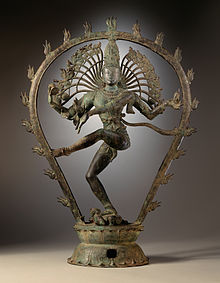| Nataraja | |
|---|---|
Lord of the dance | |
 Shiva as Nataraja, the Lord of Dance (c. 950–1000 CE) | |
| Other names | Adalvallan, Koothan, Sabesan, Ambalavanan[1] |
| Affiliation | Shiva |
| Symbols | Agni |
| Texts | Amshumadagama Uttarakamika agama |
| Part of a series on |
| Hinduism |
|---|
 |
| Part of a series on |
| Shaivism |
|---|
 |
|
|
Nataraja (Sanskrit: नटराज, IAST: Naṭarāja; Tamil: நடராஜர், Naṭarājar), also known as Adalvallan (ஆடல்வல்லான், Ādalvallāṉ),[2] is a depiction of Shiva, one of the main deities in Hinduism, as the divine cosmic dancer. His dance is called the tandava.[3][4] The pose and artwork are described in many Hindu texts such as the Tevaram and Thiruvasagam in Tamil and the Amshumadagama and Uttarakamika agama in Sanskrit and the Grantha texts. The dance murti is featured in all major Hindu temples of Shaivism,[5] and is a well-known sculptural symbol in India and popularly used as a symbol of Indian culture,[6][7] as one of the finest illustrations of Hindu art.[8][9] This form is also referred to as Kuththan (கூத்தன், Kūththaṉ), Sabesan (சபேசன், Sabēsaṉ), and Ambalavanan (அம்பலவாணன், Ambalavāṇaṉ) in various Tamil texts.[10][11][12]
The sculpture is symbolic of Shiva as the lord of dance and dramatic arts,[13] with its style and proportions made according to Hindu texts on arts. Tamil devotional texts such as the Tirumurai (The twelve books of Southern Shaivism) state that Nataraja is the form of Shiva in which he performs his functions of creation, destruction, preservation, and is also attributed with maya and the act of blessing his devotees. Thus, Nataraja is considered one of the highest forms of Shiva in Tamil Nadu, and the sculpture or the bronze idol of Nataraja is worshipped in almost all Shiva temples across Tamil Nadu.[14] It typically shows Shiva dancing in one of the Natya Shastra poses, holding various symbols[14] which vary with historic period and region,[3][15] trampling upon a demon shown as a dwarf (Apasmara or Muyalaka[4]) who symbolizes spiritual ignorance.[14][16]
The classical form of the depiction appears in a pillar of rock cut temple at Seeyamangalam – Avanibhajana Pallaveshwaram Temple constructed by a Pallava King Mahendravarman I in 6th century CE, which is known by Archeological Survey of India and Archeological Survey of Tamil Nadu as the oldest known Nataraja sculpture in India. The stone reliefs at the Ellora Caves and the Badami Caves, by around the 6th century, are also among the oldest Nataraja sculptures in India.[17][18] Ancient Tamil songs during the Bhakti movement written by the four Shaivite saints of Sambandar, Appar, Manikkavacakar, and Sundarar, popularly known as "Nalvar" (The four) extol Nataraja and describes the Nataraja Temple, Chidambaram as the home of Nataraja as the main deity, dating Nataraja worship way before the 7th century CE. Around the 8th to 10th century, statues emerged in Tamil Nadu in its mature and best-known expression in Chola bronzes, of various heights typically less than four feet,[14] some over.[19] Nataraja reliefs have been found in many parts of South East Asia such as Angkor Wat and in Bali, Cambodia, and Central Asia.[13][20][21]
- ^ "கூத்தன் சபேசன் அம்பலவாணன் நடராஜன்Sagarva Bharath Foundation". Sagarva Bharath Foundation. 20 July 2020.
- ^ Rajarajan, R. K. K. (January 2018). "If this is Citambaram-Nataraja, then where is Tillai-Kūttaṉ? An Introspective Reading of Tēvāram Hymns". In Pedarapu Chenna Reddy, ed. History, Culture and Archaeological Studies Recent Trends, Commemoration Volume to Prof. M.L.K. Murthy, Vol. II, Delhi: B.R. Publishing Corporation, Pp. 613-634, PLS. 54.1-6.
- ^ a b Cite error: The named reference
Verma2011p19was invoked but never defined (see the help page). - ^ a b Encyclopædia Britannica (2015)
- ^ Cite error: The named reference
rao223was invoked but never defined (see the help page). - ^ Cite error: The named reference
narayanan208was invoked but never defined (see the help page). - ^ Anna Libera Dallapiccola (2007). Indian Art in Detail. Harvard University Press. p. 28. ISBN 978-0-674-02691-9.
- ^ David Smith (2003). The Dance of Siva: Religion, Art and Poetry in South India. Cambridge University Press. pp. 1–2. ISBN 978-0-521-52865-8.
- ^ Frank Burch Brown (2014). The Oxford Handbook of Religion and Arts. Oxford University Press. pp. 489–490. ISBN 978-0-19-517667-4.
- ^ ValaiTamil. "அம்பலவாணன், Ambalavanan, Boy Baby Name (Tamil Name), complete collection of boy baby name, girl baby name, tamil name". ValaiTamil. Retrieved 31 October 2022.
- ^ "General Compendium-5 - GKToday". www.gktoday.in. Retrieved 31 October 2022.
- ^ "The Lord (or King) of Dance". www.speakingtree.in. Retrieved 31 October 2022.
- ^ a b Saroj Panthey (1987). Iconography of Śiva in Pahāṛī Paintings. Mittal Publications. pp. 59–60, 88. ISBN 978-81-7099-016-1.
- ^ a b c d T. A. Gopinatha Rao (1997). Elements of Hindu Iconography. Motilal Banarsidass. pp. 223–229, 237. ISBN 978-81-208-0877-5.
- ^ T. A. Gopinatha Rao (1997). Elements of Hindu Iconography. Motilal Banarsidass. pp. 236–238, 247–258. ISBN 978-81-208-0877-5.
- ^ Shiva as Lord of the Dance (Nataraja), Chola period, c. 10th/11th century The Art Institute of Chicago, United States
- ^ Cite error: The named reference
harlep126was invoked but never defined (see the help page). - ^ Archana Verma (2012). Temple Imagery from Early Mediaeval Peninsular India. Ashgate Publishing. pp. 150–151. ISBN 978-1-4094-3029-2.
- ^ Cite error: The named reference
jharle309was invoked but never defined (see the help page). - ^ Banerjee, P. (1969). "A Siva Icon from Piandjikent". Artibus Asiae. 31 (1): 73–80. doi:10.2307/3249451. JSTOR 3249451.
- ^ Mahadev Chakravarti (1986). The Concept of Rudra-Śiva Through the Ages. Motilal Banarsidass. p. 178 with footnotes. ISBN 978-81-208-0053-3.